|
|
|
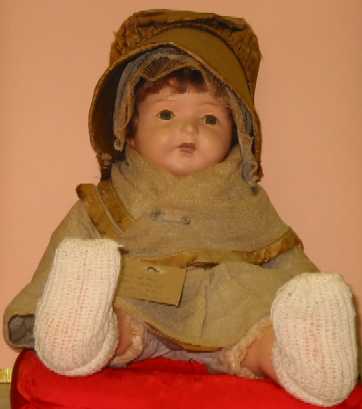
|

|
Ellen
|
|
|
I first found out about Ellen, the Friendship Doll at Hirado Kindergarten,
when I received a letter this spring from Mary Elizabeth Stanfield, a retired
librarian who lives in Wilmington, Ohio, and who now works as a volunteer at
the Peace Resource Center at Wilmington College. About 15 years ago she wrote
a pamphlet on the story of Ellen C., The Friendly Doll. She also sent
me a copy of Little Mary, The Blue-eyed Doll, which is an English
translation of a children's book by Eiko Takeda, a Japanese children's
author who has published many books about the Friendship Dolls exchanged
between the U.S. and Japan in 1927. The inspiration for the book published in
1984 about Little Mary came from Ms. Takeda's visit to Hirado Kindergarten
in 1982.
|
|
|
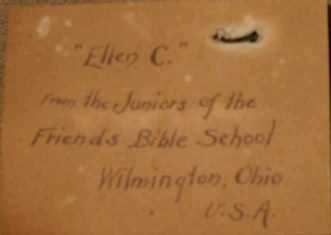
|
|
|
Tag Attached to Ellen
|

|
|
|
Ellen C. was one of seven dolls sent to Japan in
1927 by the Juniors of the Friends Bible School in Wilmington, Ohio, which is
written on a tag attached to the doll. In 1983, Hirobumi Toyama, a high school
English teacher (now retired) in Nagasaki City, wrote a letter to the Friends
Bible School to try to find out more about the people who sent Mary C. as a
gift to Japan. Ms. Stanfield, a member of the Wilmington Friends Meeting,
responded to Mr. Toyama's letter. Hirado Kindergarten found out about the
Friends (or Quakers) who had sent the doll in 1927 and about the Wilmington
College teacher for whom the doll was named. The people living in Wilmington
learned that the doll sent so long ago survived World War II, when many dolls
were destroyed as spies sent from the enemy. Nagasaki Prefecture received 214
Friendship Dolls from America in 1927, but only two have been found.
|
|
|
|
|
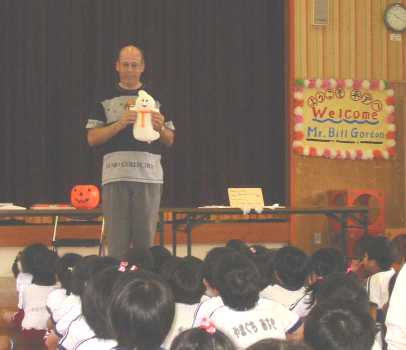
|

|
Spooky, a Friendly Ghost,
Given to School as Present
|
|
|
After a long morning walk by the beautiful harbor
of Hirado, I went to visit the children and teachers of Hirado Kindergarten.
When I arrived, I met Yoshiko Ikeda, who worked at the kindergarten for 38
years (1952-1990) and who knew a great deal about the history of the doll
Ellen. The head of the kindergarten, Mr. Matsunaga, showed an interesting
ten-minute video on the history of the Friendship Dolls in Nagasaki
Prefecture. Next I went to talk with the 60 children and 5 teachers at the
kindergarten. The children enthusiastically sang a song, and they recited
words of greeting at the beginning of the assembly and a thank-you message at
the end. We practiced together the correct way to shake hands and greet people
in America, and then I showed the children many items that Americans use to
celebrate Halloween. They were quite excited to each receive a sheet of
Halloween stickers and a small roll of candy. I showed them a couple of
picture books, one on Halloween and one where they had to guess what was
inside of something (for example, penguin inside of iceberg). When I finished
this picture book, I had them to guess what was inside a large sack after
giving them a couple of hints, and one child soon guessed that it was Mary,
the school's Friendship Doll from 1927. At the end of the assembly, the
children presented me with two large sheets of their art work and some long
necklaces made from paper they had colored.
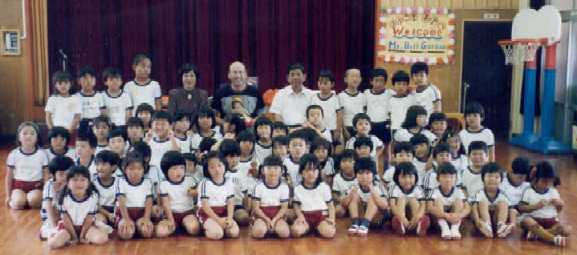
With Hirado Kindergarten Children
|
|
|
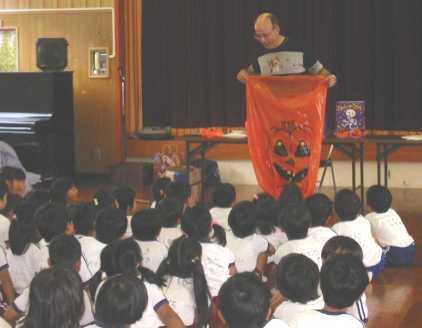
|
|
Some Children Use Large Bags
for Halloween Candy
|

|
|
|
After the assembly, I talked for some time with a
reporter from the Nagasaki Shimbun, who had been at the school during
the morning. When asked about what impressed me most about the doll at Hirado
Kindergarten, I said that it was her authentic old-time Quaker dress and
bonnet. Since he had never heard of the Quakers, I explained that they strongly
believed in peace and were against war of all types. The purpose of sending
dolls in 1927 was to strengthen relations and to secure peace between Japan and
the U.S., so this is probably why the Quakers from Wilmington, Ohio, sent this
doll to Japan.
After lunch I had a chance to play with the children. We played soccer, drew
pictures, and played a version of tag. A couple of girls showed me their talent
at jumping rope, and I also gave it a try. After the playtime, the head of the
kindergarten, Mr. Matsunaga, presented me with a couple of cute Hirado dolls
made of cloth. This was my third visit to a Japanese kindergarten, but he was
the first man I had seen working at a kindergarten. He explained that he came
to work at the kindergarten about three years ago after his retirement as an
elementary school teacher.
|
|
|
|
|
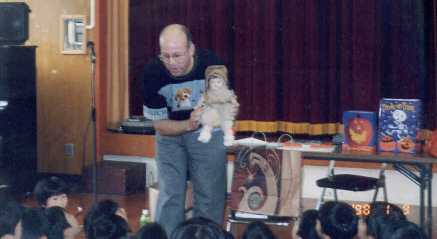
|

|
Ellen Comes Out From Hiding in
Sack
|
|
|
I wished I had more time to see the historical sites of Hirado Island, which
is connected to the main part of Nagasaki Prefecture by a long reddish-orange
bridge, but I had to return to Nagasaki City for an evening party with the Miss
Nagasaki Homecoming Committee. Hirado has an imposing castle that overlooks the
harbor. In the last half of the 1500s and the first half of the 1600s, Hirado
was a thriving trading port, and the city still retains some the Dutch
influence from that time. Hirado was the first seaport opened to Dutch traders
at a time when Japan had practically no contact with the outside world. As
Japan's first international trading port, Hirado is the place of many
interesting firsts in Japan, including bread (1550), tobacco (1601), paint
(1609), and beer (1613).
|
|
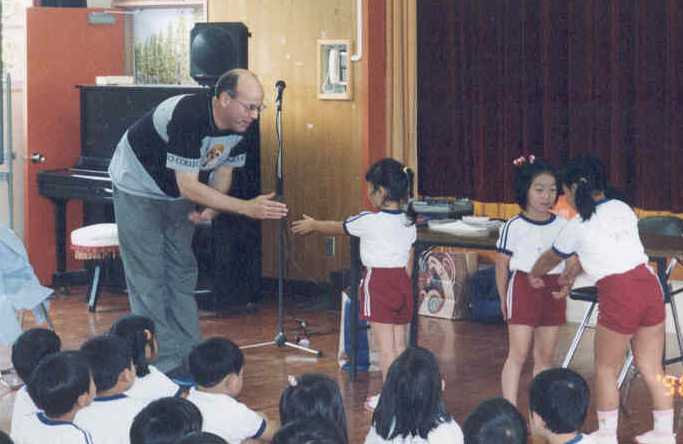
Beginning of Lesson on How to Shake Hands
More Practice Required!!
|
|
|